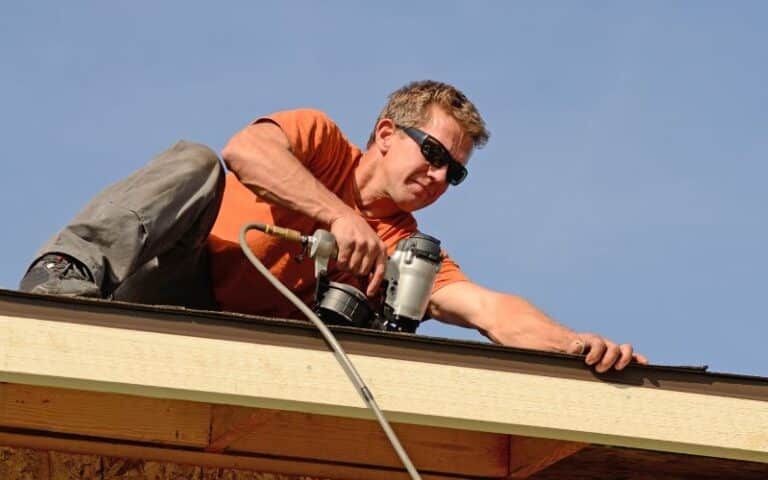You will have to get the size of roofing staples that fit into the range of roofing materials to ensure that the end product of the roofing process is structurally sound.
Unfortunately, many stores only offer two-length options for staples. To get a full range of options, you could seek out bigger stores that solely specialize in roofing and roofing materials with better buying choice offers.
For a 30lb felt, you should use T50 staples which generally have ⅜ inch wide crowns and a length variation that include ¼, ⅚, ⅜, and ½ inches. The variation in the lengths of the T50 staples entirely depends on the thickness of the felt and the density of the wood beneath it.
Ready for a Roofing Quiz?
What Size Staples Required for 30lb Felt?
A stainless steel T50 staple with a length of ½ inches is a good choice for attaching a 30lb felt underlayment during roofing. Heavy-duty roofing staples are essential for additional strength, especially in high wind areas.
An example of such heavy-duty staples is the Arrow heavy-duty roofing staples which ensure a firm grip on the 30lb felt underlayment or roofing tar paper.
As roofing felt underlayments have a considerable role in keeping your home safe in harsh weather conditions that might compromise, you should not overlook the roof shingles and adequately sized roofing staples.
These keep the roofing felt attached and protect the roof deck from wind and water.
As long as the required size of stainless steel T50 staples are used, the felt underlayment can offer protection until the shingles are replaced.
However, if the wrong size of T50 staples is used during storms or in areas of high wind conditions, the 30lb roofing felt underlayment would not stay down.
The wind could forcefully pull off the roofing felt, and this force can cause the wrong size staplers to rip through the roofing felt and destroy it.
In cases where the roof shingles are compromised, a 30lb roofing felt underlayment installed with T50 staples with lengths other than ½ inches would be unable to protect the wood deck beneath from the harsh exposure, as it should.
Can You Staple Roofing Felt?
Yes. Stapling roofing felt is a faster and easier way of attaching roofing felt underlayment to your wood deck. This is possible because the roofing felt is thin, more or less heavy paper.
The thickness of roofing felt is not measured by its depth; instead, it is by its weight. This is measured in pounds per square.
Although staples do the work fine, some professionals prefer to hand-nail their felt underlayment, but this takes more effort and time when compared to using staples.
In addition, roofing nails without caps sometimes tear right through the felt underlayment, especially when the felt underlayment is exposed to the wind before the shingles are attached.
Therefore these roofers go for roofing nails with plastic caps to prevent tears and increase the waterproofing capacity of the structure.
In addition, it is appropriate to secure felt underlayment with staples, backed up by many local roofing codes. Despite this, some individuals purely prefer hand nailed felt.
Regardless of these variations in preferences, experienced roofers have proven as it does not matter if staples or nails are used to attach felt underlayment during roofing.
This is because the staples or nails are only there to hold the felt underlayment down, while many roof shingles are stacked on top of the felt.
How Many Staples for Roofing Felt?
You should plan for 400 staples per square to attach your roofing felt underlayment in your usage estimates. Furthermore, you would need four fasteners per 3-tab shingle to secure the roof shingles.
When you use a dual-capacity tack hammer stapler for roofing, felt, going through the numerous staples will be done at record speed.
At the same time, in instances where easily purchasable plastic cap roofing nails are used, to further increase the watertight integrity of the roofing felt, 400 nails per square is also recommended.
Even for a roofer who prefers to hand nail roofing felt, going through the painstaking process of hand nailing felt can be made easier with a hand Stringer nailer.
This is the tool to quickly and safely install your roofing felt underlayments. A Stringer cap nailer has a fastener capacity of 200 cap nails and reloading it is easy and efficient.
It allows sizes of 1-inch cap diameter and 1-inch nail length for collated cap nails for house wraps and roofing underlayments.
Hand Stringer nailers go a long way in saving time when roofing nails are used instead of T50 staples.
What are T50 Staples used for?
T50 staples are used for all heavy-duty stapling applications, including installing roofing underlayments.
Other heavy-duty stapling applications include installing house wraps and insulation, window treatments, masonry, wood crafts, upholstering of furniture, and many other DIY and professional work.
These staples are made from heavy-duty steel material, which enables precise stapling and ensures strength, which lasts a very long time.
In addition, it has been proven to have excellent holding power for T50 staples to be used for roofing projects.
Stapling as a method of roofing felt installation is the first choice of many roofers. One of the reasons for this is that staples cost less than nails and offer an excellent holding strength.
It attaches the underlayment closer together and covers a greater space area. You can tack 30lb roofing felt underlayments using a stainless steel T50 stapler.
The hammer tack staplers fit the sizes of Arrow T50 staplers of ¼, ½,⅜, 5/16, 9/16, and 17/32 inches.
The most timely and practical equipment for installing the roofing felt with staplers, a sure-grip handle, and a dual capacity rear load magazine.
The building tack hammer stapler has been an efficient artistry tool since the 1950s, and it features solid chrome steel parts for durability. Staple guns are also easy to repair when jammed.
How Thick and Big are T50 Staples?
The thickness of a T50 staple is indicated by numbers ranging from 23, 24, to 26. The lower the digit, the thicker the T50 staple.
These digits that show the exact gauge of the staples are shown on the packaging, along with the length.
T50 staples generally have flat tops that are ⅜ inches wide, but the thickness and length determine their size. As these staples vary in length, the specific sizes are indicated alongside the gauge of the staple wire in this format:
26/6. It means the T50 staples have a thickness of 26 and a wire length of 6mm, that is, ¼ inches.
When faced with multiple buying choice offers in stores, many individuals are a little confused on determining the gauge of the varying T50 staples.
However, with the explanation in this guide, it should be easy to get the proper range of roofing tools.
Summary
Roofing is a job for at least two persons, and it requires a professional roofer’s knowledge, skill, and experience.
In addition, a roofing structure is not sound unless suitable sizes of roofing staples and roofing felt underlayments are used.
This guide is one of the many ways of gaining the right know-how to ensure your roofing felt is well attached.
Depending on individual choice and the local roofing codes in an area, staples or roofing nails can efficiently install the roofing felt underlayments.






